-
项目名称
- 国家自然科学基金"红壤丘陵区生物结皮驱动下土壤特性动态变化及侵蚀响应"(42077066), "丹江口库区新修梯田土壤水文属性对坡面水文过程影响及侵蚀响应"(42477354)
-
第一作者简介
- 张航宇(1997-), 女, 硕士研究生。主要研究方向: 土壤侵蚀与水土保持。E-mail: ZhangHangYuNing@163.com
-
通信作者简介
- 郭忠录(1980-), 男, 教授, 博导, 博士。主要研究方向: 土壤侵蚀与水土保持。E-mail: zlguo@mail.hzau.edu.cn
-
文章历史
-
收稿日期:2022-05-19
修回日期:2024-10-31
生物土壤结皮(biological soil crusts, BSCs)是荒漠景观的重要组分之一,是由蓝藻、绿藻、地衣、藓类、微生物以及相关的其他生物体通过菌丝体、假根和分泌物等与土壤表层颗粒胶结形成的、覆盖于地表的有机复合体[1-2]。作为连接土壤和植被的界面层,BSCs广泛分布于各类气候区,发挥着极其重要的生态系统功能。
BSCs研究早期主要在美国、德国、西班牙、以色列及澳大利亚进行。在我国,20世纪90年代末以来,有关BSCs研究逐渐增多,对BSCs群落组成、结构、演替特征、生态功能及干扰响应等开展大量的研究[3],特别是近10年来,对其研究不断深入,文献数量不断增长,促进了我国荒漠化生态系统生态学、干旱区生态水文学及半干旱、半湿润区土壤侵蚀与水土保持学的发展,在国际上上产生较大影响[3]。笔者利用CiteSpace和VOSviewer分析工具,通过文献计量学和知识图谱可视化方法对BSCs领域进行统计分析和内容挖掘,梳理我国BSCs领域研究发展历程和研究热点。
1 方法与数据 1.1 研究方法CiteSpace是由美国德雷塞尔大学陈超美博士应用Java语言开发的一款信息可视化软件,其通过一系列可视化图谱的绘制形成对学科演化潜在动力机制的分析和学科发展前沿的探测[4]。VOSviewer是由荷兰莱顿大学Nees Jan van Eck和Ludo Waltman开发的用于绘制科学知识图谱的文献计量分析软件[5]。二者绘制图谱的信息量大,视觉效果好,可以从不同的侧面提供科研视角[6]。笔者采用CiteSpace 5.8.R1和VOSviewer对生物结皮的相关文献进行可视化分析。
1.2 数据来源本研究中文文献源自CNKI数据库,检索式为:SU=‘生物结皮’ or SU=‘结皮’ or SU=‘生物土壤结皮’ or SU=‘藻结皮’ or SU=‘藓结皮’ or SU= ‘地衣结皮’ or SU=‘混合结皮’),只选择中文学术期刊,时间跨度为1964—2021年12月31日共检索到2 782条结果。再次进行人工筛选,剔除会议、通知、新闻以及与研究主题不相关的文献,最终得到1 627篇与生物土壤结皮领域相关的文献。英文文献选取自Web of Science数据库,检索式为:‘biological soil crusts’ OR ‘biological crusts’ OR ‘biocrusts’ OR ‘moss biocrusts’ OR ‘cyanobacterial biocrusts’ OR ‘lichen biocrusts’,人工筛选出我国学者的文献,共得到620篇。
2 结果与分析 2.1 中文期刊BSCs主题研究文献特征 2.1.1 BSCs主题研究的文献量及时间分布特征文献发文量的变化能够从一定程度上反应某个学科领域的研究水平和发展程度,是衡量该领域研究进展的重要指标。BSCs发文量从1964年至今整体呈上升趋势(图 1),大致可以分为3阶段:1)2000年以前关于BSCs的发文量基本在0~5篇之间,年增长率波动较大是因为该时段年发文量基数较小。1964—1990年间主要探索盐结皮的发生演变过程,耐盐植物的发掘及土壤盐渍化的改良措施;1990—2000年间主要研究BSCs作为一种新型的人工生态防护体系的措施其防风固沙的物理原因,研究地区主要集中在腾格里沙漠边缘的沙坡头地区;以及部分藻类结皮的生物学特性。2)2001—2009年我国BSCs研究整体呈迅猛发展的趋势,主要研究藻类结皮[7]、藓类结皮的区系组成、胶结机理及其分布特点[8];BSCs与水文循环的耦合过程;藻类胞外多糖在沙漠土壤成土中的作用等。3)2010—2021年间发文量增速放缓,处于波动上升阶段,年平均发文量达95.5篇。这一时期各位学者对BSCs领域的研究逐渐深入,研究内容更加广泛,方法技术更加先进,主要研究BSCs在干旱、低温、降雪等不利环境胁迫下的响应机制;结皮覆盖下的土壤微生物、酶活性对于水热因子变化的反应规律[9];不同3皮覆盖结构的水土保持效应等[10]。
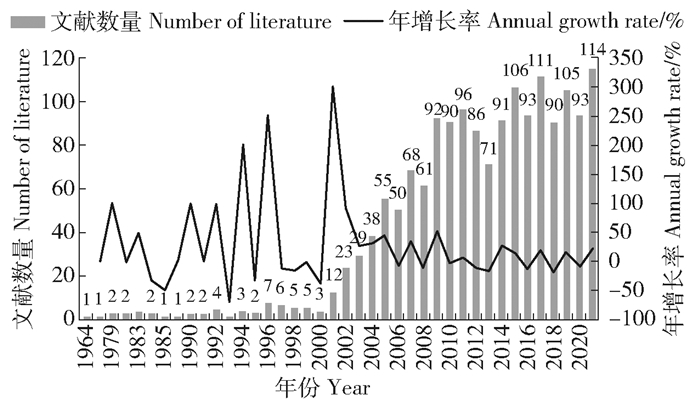
|
图 1 BSCs主题研究的中文文献量及年增长率 Fig. 1 Number and annual growth rate of Chinese literature on BSCs |
通过对作者合作网络进行分析,能够获知BSCs领域的杰出代表人物和主要科研团队。来自2 317位作者共1 627篇中文文献。应用VOSviewer软件对作者进行可视化分析,图中节点的大小表示该作者发文量多少,节点间距离的远近代表作者之间合作密切程度,连线条数表示作者之间合作的次数。将作者发文数量最小值设置为3,共有407位作者达到阈值,在这407位作者中有151位作者与其他作者没有合作,图 2a中仅展示256位相互合作过的作者的聚类视图。这256位作者共产生5个聚类,948条连线,不同颜色代表不同聚类。
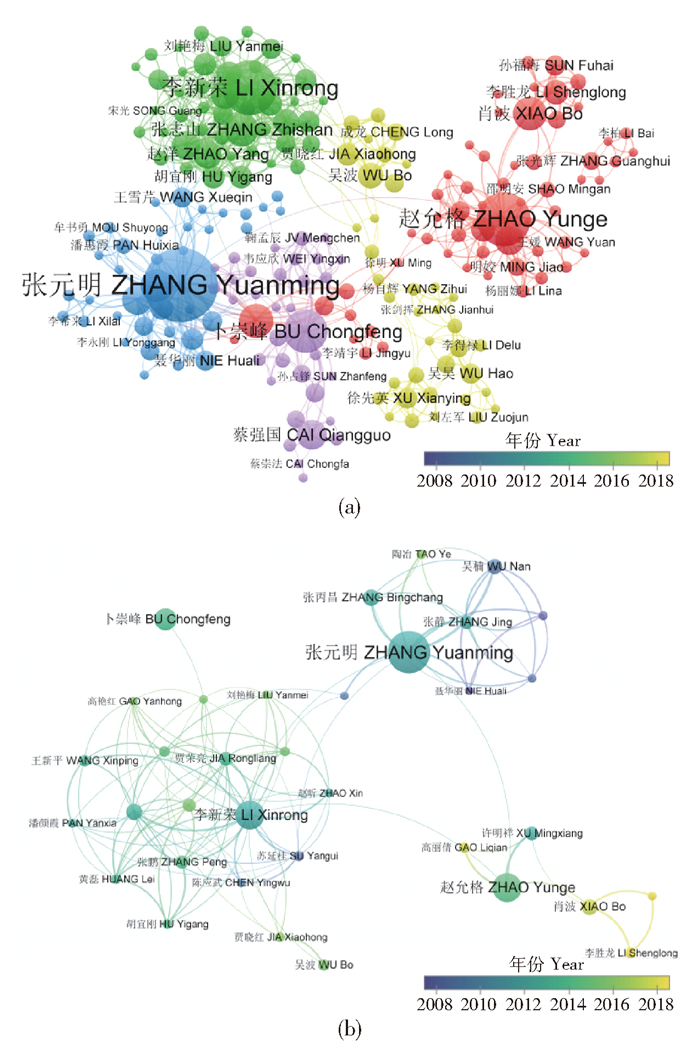
|
Different colors indicate different clusters, and authors who cooperate more closely with each other form a cluster. 图 2 BSCs主题研究作者聚类视图 Fig. 2 Network visualization of authors studying BSCs |
如图 2所示,绿色部分是以Li等[11]为核心的中国科学院西北生态环境资源研究所团队,其该领域中文文献数量为67篇,主要研究内容为沙区BSCs的基本理化性质、植物固沙的生态水文过程、BSCs对沙区土壤环境因子变化的响应与反馈机理等,主要研究区域集中在腾格里沙漠。深蓝色部分以张元明为核心的中国科学院新疆生态与地理研究所团队,其该领域中文文献数量为97篇,研究内容有荒漠生态系统结构与功能、BSCs的群落属性对温带荒漠生态系统多功能性的影响[12]、BSCs的人工培养及其对受损荒漠地表的生态修复等,主要研究区域集中在古尔班通古特沙漠。紫色部分是以赵允格为代表的西北农林科技大学研究团队,其该领域中文文献数量为50篇,研究内容有黄土丘陵区的BSCs的生态功能、BSCs抗侵蚀机理[13]及黄土高原生物结皮对坡面水土流失过程的影响等。黄色部分是以卜崇峰为代表研究团队,其该领域中文文献数量为35篇,研究内容有毛乌素沙地的BSCs空间分布[14]、固碳功能[15]及其水土保持效应等。各个群体之间的链接强度不高,但是群体内部之间的合作很强。
将作者发文数量最小值设置为10,有50位作者达到阈值,图 2b中仅展示39位相互合作过的作者的叠加视图。颜色越趋于深蓝色,表示作者开始研究该领域的时间越早,颜色越趋于黄色则表示该作者近些年来在该领域较为活跃,承担该领域的科研项目较多。通过颜色的渐变能看出来核心作者的带动辐射作用,近年来新兴的较为活跃的有中国农业大学肖波师生团队,近期主要研究为黄土高原生物结皮土壤水热耦合机制与水汽运动过程[16]。西北农林科技大学高丽倩团队,近期主要研究土壤颗粒组成对BSCs稳定性的影响及机制、黄土高原BSCs对坡面水土流失过程的影响[17]。
2.1.3 BSCs主题研究的载文期刊和机构1 627篇中文文献来自213种期刊,文献分布较为分散,载文量前10的期刊均为核心期刊。如图 3所示,《中国沙漠》以130篇的载文量位居第1,《干旱区研究》以43篇的载文量位居第5,《干旱区资源与环境》以29篇的载文量位居第9,3种期刊共计载文202篇,比例为12.27%,说明在西北干旱地区、特别是一些沙漠地区的BSCs有较多的研究,而对南方地区的BSCs的研究相对较少。BSCs是许多极端环境条件下生态修复的先锋类群,不管是针对北方地区的沙漠化阻控还是对南方地区石漠化的减缓[18]都非常具有研究意义。
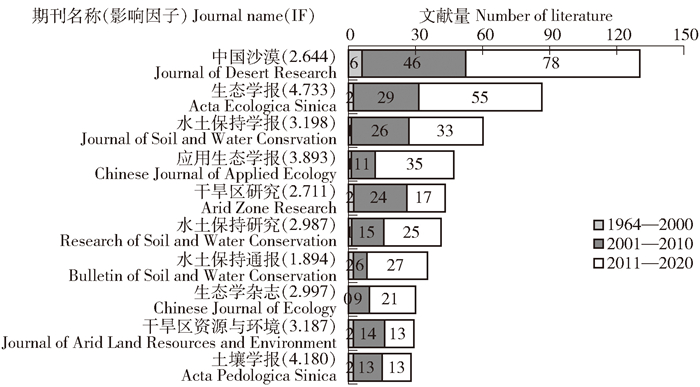
|
图 3 BSCs主题研究发文量前10的中文期刊 Fig. 3 Top 10 Chinese journals of literature on BSCs |
基于CiteSpace 5.8.R1对BSCs主题研究的发文机构进行可视化分析,用以反映我国该领域各个机构之间的关系,图 4中共有227个节点,234条连接,网络密度0.009。说明各机构之间对话较少,对于已有成果的研究较少利用。从地域来看,发文机构的分布不均匀,主要集中在我国北方地区。中国科学院大学、中国科学院新疆生态与地理研究所、中国科学院寒区旱区环境与工程研究所是研究BSCs最多的机构。其次,中科院水利部水土保持研究所与西北农林科技大学常年来致力于各种极端环境下的生态修复,因此对于生物结皮的研究也较为深入。
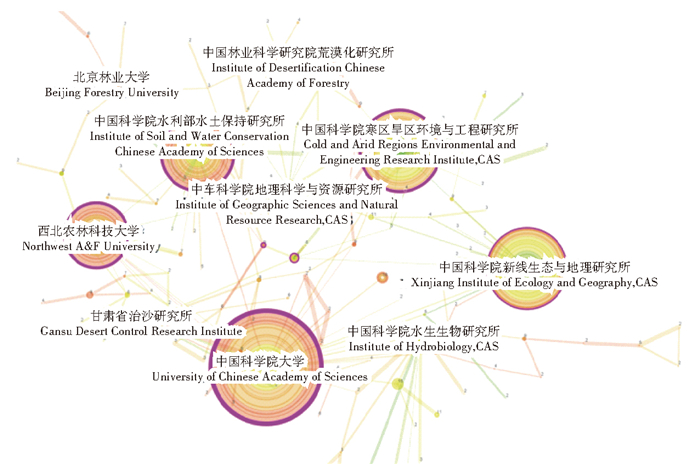
|
图 4 BSCs主题研究发文机构图谱 Fig. 4 Institute map of publishing literature on BSCs |
关键词是一篇文献的核心与精髓,起着统领全文的作用。对1 627篇文献6 984个关键词进行共现分析,探寻BSCs领域研究方向。利用VOSviewer软件绘制关键词标签视图,标签视图是使用1个圆圈和标签来代表 1个元素,圆圈大小代表权重高低。拥有相同颜色的圆圈属于同一个聚类[5]。将关键词出现的最小次数设置为5,在6 984个关键词中达到阈值的中文关键词个数为474个,关键词之间的连线共有2 105条,共形成5个聚类,不同颜色代表不同聚类。
由图 5可知,聚类1(红色)主要研究的是在人工模拟降雨的条件下BSCs对于土壤抗冲性的增强、雨滴动能的削弱、降雨入渗产流的阻碍等生态水文过程的调控机理以及BSCs的水土保持效应等。通过室内模拟降雨试验研究BSCs发育特征对水分入渗的影响,结果表明喀斯特坡面BSCs发育的空间变异程度高,对水分入渗过程影响显著[19]。聚类2(紫色)主要研究的是细菌固氮活性对水分、温度等环境因子的响应特征,BSCs对于气候变化的敏感性[20],藻类胞外多糖对于沙漠土壤的成土作用,温性荒漠地区的碳释放、氮固定等。聚类3(蓝色)主要针对黄土丘陵地区[21]土壤理化性质,BSCs多样性、物种更替、维持其结构的胶结方式及最适物种组成等。通过定量地研究不同生物量BSCs对土壤物理属性的影响,为揭示BSCs抗侵蚀机理提供科学参考[22]。聚类4(黄色)主要针对干旱、低温、降雪[23]等极端环境的胁迫下,BSCs的生理生化反应,土壤酶活性、土壤呼吸、藻、藓类光合速率的响应机制,结皮对凝结水的捕获等。聚类5(绿色)主要研究人工培养的BSCs对水文循环、水热耦合[24]、养分吸收的影响,及其在生态恢复实践中的应用。
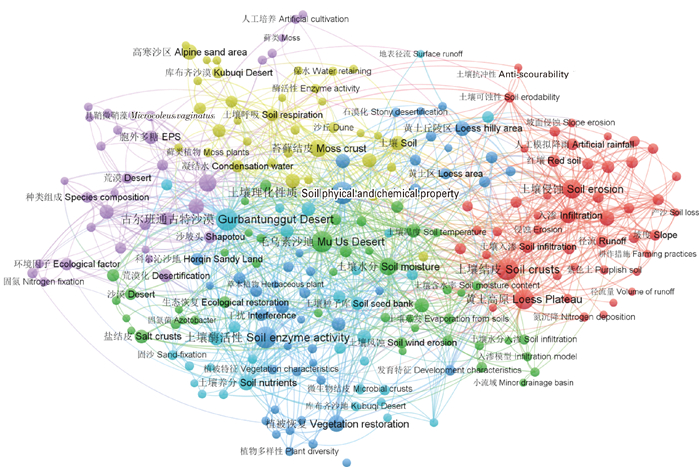
|
Red: Biological soil crusts and soil hydrological processes. Purple: Soil and water conservation effects of biological soil crusts. Blue: Composition and diversity of biological soil crusts. Yellow: Ecophysiological response of biological soil crusts to environmental stress. Green: Artificial cultivation of biological soil crusts and ecological restoration practice 图 5 BSCs主题研究关键词聚类图谱 Fig. 5 Cluster map of keywords on BSCs |
BSCs主题的发文量在2000年以前少有涉及,从2002年开始逐步攀升,个别年份略有回落,与中文期刊文献量基本同频(图 6)。BSCs主题研究国内作者的发文前3的期刊分别是《Catena》《Geoderma》和《Soil Biology and Biochemistry》(图 7)。利用CiteSpace对英文620篇文献作者进行可视化分析(图 8),图中显示发文量达到20篇以上的作者。李新荣和张元明依然处于核心地位,其该领域的英文文献分别达到91篇和58篇,胡春香以45篇的文献量位居第3。该领域的作者大概分为3部分,以李新荣为代表的中科院西北院,包括贾荣亮、刘立超、赵洋、张志山、王新平等;以张元明为代表的中科院新疆所,包括张静等;以胡春香为代表的中科院水生所,包括刘永定、兰书斌、吴丽等。与中文文献50篇相比,赵允格英文文献发表 24篇相对较少,兰书斌发表的英文文献达30篇,但中文文献较少。
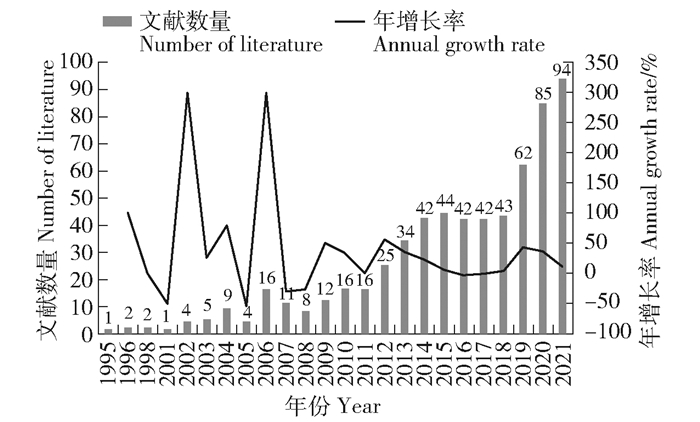
|
图 6 BSCs主题研究的英文文献量及年增长率 Fig. 6 Number and annual growth rate of English literature on BSCs |
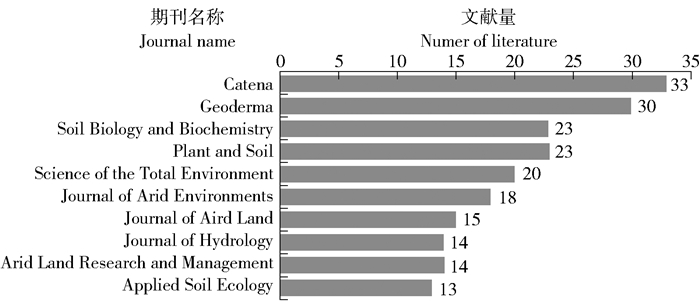
|
图 7 BSCs主题研究发文量前10的英文期刊 Fig. 7 Top 10 English journals of literature on BSCs |
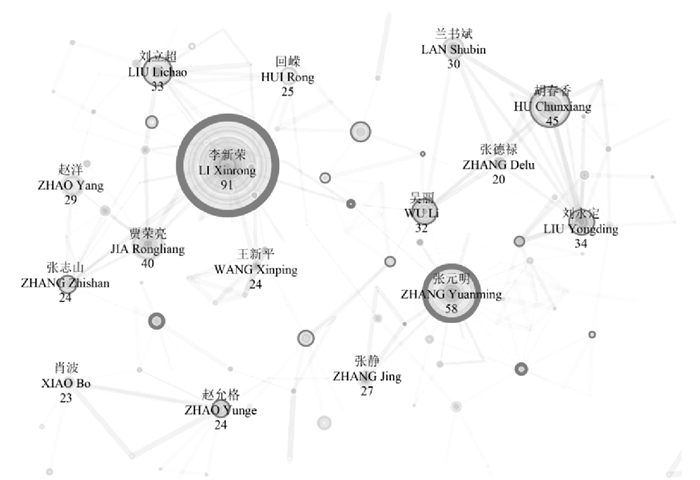
|
图中数字表示该作者在英文期刊中发表过的有关BSCs主题的文献数量。 The figures in the graph indicate the number of articles on the topic ofBSCs published by the author in English journals 图 8 英文期刊BSCs主题研究国内作者聚类图 Fig. 8 Clustering of domestic authors in English journals on BSCs |
基于CiteSpace对于生物土壤结皮的关键词进行时间序列分析(图 9),时间设置为2000—2021年,时间切片为5 a,提取每个时间切片中高频词进行分析,节点越大表示出现的次数越多。2000—2005年间集中出现了“cryptogamic crust”“microbiotic crust”“crust”“algal crust”和“biological soil crust”,与此同时中文期刊的文献量也在同步增长,这个时期英文文献主要围绕“nitrogen fixation”“succession”“polysaccharide”等展开研究,BSCs对于“infiltration”“erosion”的影响,以及BSCs对于各类“distribution”的响应,研究区主要在“Tengger desert”,表示以李新荣为代表的团队开始活跃。2006—2010年间主要结合“precipitation”“evaporation”,以及一些极端环境的胁迫“desertification”“salts tress”,BSCs的“diversity”“succession”“restoration”等,微观层面多研究BSCs的“photosynthesis”,并开始转向演替更为成熟的“moss crust”, 研究区域出现了“Gurbantunggut desert”, 表示以张元明为代表的团队开始活跃。2011—2015年间多研究“carbon”“organic matter”,并以“chlorophyll fluorescence”探究光合作用,更有“enzyme activity”“exopolysaccharide”等分子层面的探索,“runoff”对于“erodibility”的影响等;2016—2020年间,研究区域出现了“Loess Plateau”, 并结合当前的“climate change”[25],配合遥感等新兴技术进行BSCs“spatial distribution”的分析,且倾向于研究“fungal community”“microbial community”“bacterial community”及“community structure”等,通过调节群落结构,微生物代谢途径促进BSCs生长[26]。
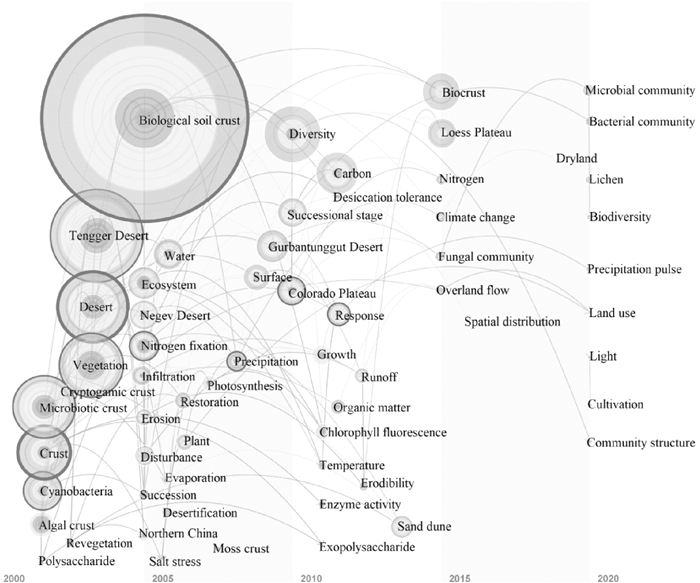
|
图 9 英文期刊BSCs主题研究关键词时区图 Fig. 9 Keywords time zone map of BSCs in English journals |
对BSCs研究状况分析发现:1)发文量从1964年至今整体呈上升趋势,经历了起步阶段、迅速发展阶段、高平稳发展阶段;2)中文期刊中核心作者群分别是李新荣、张元明、赵允格、卜崇峰等及他们所带领的团队,近些年新兴的、较为活跃的有肖波团队等;英文期刊中核心作者群主要是李新荣团队、张元明团队以及胡春香团队;3)中文期刊载文最多的3个期刊是《中国沙漠》《生态学报》《水土保持学报》,发文机构排名前3分别是中国科学院大学、中国科学院新疆生态与地理研究所和中国科学院寒区旱区环境与工程研究所。英文期刊载文最多的5个期刊分别是《Catena》《Geoderma》《Soil Biology and Biochemistry》《Plant and Soil》和《Science of the Total Environment》。
结合中英文文献对BSCs研究热点分析发现:1)5个热点聚类核心关键词分别是“BSCs的生态水文调控机理”“温性荒漠BSCs的碳、氮循环”“黄土丘陵区土壤的理化性质”“BSCs对环境胁迫的生理生化响应”“BSCs的生态功能及其水土保持效应”;2)结合BSCs高频词、突现词以及时区图发现,古尔班通古特沙漠、科尔沁沙地、毛乌素沙地、黄土丘陵区等地一直是BSCs研究的重点区域。近十年间,诸多学者通过大量实验追踪BSCs抗侵蚀过程;挖掘其对环境胁迫的响应及协同机理;模拟水分养分的迁移路径;探索人工促进BSCs快速固沙技术;量化BSCs的水土保持功能等。并且研究趋于微观层面,针对BSCs的光合作用、呼吸作用及其对极端环境的响应机制;BSCs的发育演替对土壤酶活性的影响;BSCs与微生物群落的交互作用;BSCs的碳氮固存功能及对凝结水的捕获等进行多方面深层次地探究挖掘。
结合研究现状分析,未来的研究可能会趋于以下方面:1)研究视野从局地向区域和全球尺度转变;2)多学科融合,打破学科壁垒统筹发展,如基于分子生物学以探究BSCs的胶结机理,从分子层面改变胞外多糖以提高胶结强度等;3)科研过程与现代技术有更紧密的融合,如利用先进的遥感技术分析BSCs的空间分布、碳氮固存功能,结合医学CT扫描技术以探究BSCs的孔隙结构等;4)科研工作以实际应用为落脚点,对人工培育BSCs如何在水土保持及生态修复的实践中应用有更深的研究与剖析;5)人工培育BSCs快速固沙技术及其对种子萌发、幼苗生长、养分吸收的交互影响。
| [1] |
WEST N E. Structure and functions of microphytic soil crusts in wildland ecosystems of arid to semi-arid regions[J]. Advances in Ecological Research, 1990, 20: 179. |
| [2] |
ELDRIDGE D J, GREENE R S B. Microbiotic soil crusts: A review of their roles in soil and ecological processes in the rangelands of Australia[J]. Australian Journal of Soil Research, 1994, 32(3): 389. DOI:10.1071/SR9940389 |
| [3] |
李新荣, 谭会娟, 回嵘, 等. 中国荒漠与沙地生物土壤结皮研究[J]. 科学通报, 2018, 63(23): 2320. LI Xinrong, TAN Huijuan, HUI Rong, et al. Study on biological soil crusts in desert and sandy land of China[J]. Chinese Science Bulletin, 2018, 63(23): 2320. |
| [4] |
陈悦, 陈超美, 刘则渊, 等. CiteSpace知识图谱的方法论功能[J]. 科学学研究, 2015, 33(2): 242. CHEN Yue, CHEN Chaomei, LIU Zeyuan, et al. The methodological function of CiteSpace knowledge map[J]. Studies in Science of Science, 2015, 33(2): 242. DOI:10.3969/j.issn.1003-2053.2015.02.009 |
| [5] |
高凯. 文献计量分析软件VOSviewer的应用研究[J]. 科技情报开发与经济, 2015, 25(12): 95. GAO Kai. Research on the application of literature metrology analysis software VOSviewer[J]. SCI-TECH Information Development & Economy, 2015, 25(12): 95. |
| [6] |
宋秀芳, 迟培娟. VOSviewer与CiteSpace应用比较研究[J]. 情报科学, 2016, 34(7): 108. SONG Xiufang, CHI Peijuan. Comparative study of the data analysis results by VOSviewer and CiteSpace[J]. Information Science, 2016, 34(7): 108. |
| [7] |
张丙昌, 张元明, 赵建成, 等. 古尔班通古特沙漠生物结皮不同发育阶段中藻类的变化[J]. 生态学报, 2009, 29(1): 9. ZHANG Bingchang, ZHANG Yuanming, ZHAO Jiancheng, et al. Variation in algal composition among different developmental stages of biological soil crusts in Gurbantunggut Desert[J]. Acta Ecologica Sinica, 2009, 29(1): 9. |
| [8] |
刘法, 张光辉, 杨海龙, 等. 风向及油蒿植株对生物结皮分布特征的影响[J]. 中国水土保持科学, 2014, 12(4): 100. LIU Fa, ZHANG Guanghui, YANG Hailong, et al. Effect of wind direction and Artemisia ordosica on the distribution pattern of biological soil crust[J]. Science of Soil and Water Conservation, 2014, 12(4): 100. DOI:10.3969/j.issn.1672-3007.2014.04.016 |
| [9] |
徐军山, 苏雪, 贾志鹏, 等. 增温对结皮土壤系统氮转化速率及微生物生物量碳氮与酶活性的影响[J]. 土壤学报, 2021, 58(3): 788. XU Junshan, SU Xue, JIA Zhipeng, et al. Effects of warming on soil nitrogen transformation rates, microbial biomass carbon and nitrogen and enzyme activity in crust-covered soil system[J]. Acta Pedologica Sinica, 2021, 58(3): 788. |
| [10] |
谢申琦, 高丽倩, 赵允格, 等. 模拟降雨条件下生物结皮坡面产流产沙对雨强的响应[J]. 应用生态学报, 2019, 30(2): 391. XIE Shenqi, GAO Liqian, ZHAO Yunge, et al. Responses of runoff and soil loss from biological soil crustal slope to rainfall intensity under simulated rainfall[J]. Chinese Journal of Applied Ecology, 2019, 30(2): 391. |
| [11] |
LI Xinrong, JIA Rongliang, ZHANG Zhishan, et al. Hydrological response of biological soil crusts to global warming: A ten-year simulative study[J]. Global Change Biology, 2018, 24(10): 4960. DOI:10.1111/gcb.14378 |
| [12] |
ZHOU Xiaobing, TAO Ye, YIN Benfeng, et al. Nitrogen pools in soil covered by biological soil crusts of different successional stages in a temperate desert in central Asia[J]. Geoderma, 2020, 366(1): 114166. |
| [13] |
ZHAO Yunge, QIN Ningqiang, Weber Bettina, et al. Response of biological soil crusts to raindrop erosivity and underlying influences in the hilly Loess Plateau region, China[J]. Biodiversity and Conservation, 2014, 23(7): 1669. |
| [14] |
JU Mengchen, ZHANG Tinglong, LI Xinkai, et al. Large scale environmental drivers of biocrust distribution and development across a sandy desert in China[J]. Catena, 2021, 200: 105137. |
| [15] |
孟杰, 卜崇峰, 李莉, 等. 侵蚀条件下生物结皮对坡面土壤碳氮的影响[J]. 中国水土保持科学, 2011, 9(3): 45. MENG Jie, BU Chongfeng, LI Li, et al. Effects of biological soil crust on slope soil carbon and nitrogen under erosion conditions[J]. Science of Soil and Water Conservation, 2011, 9(3): 45. DOI:10.3969/j.issn.1672-3007.2011.03.009 |
| [16] |
窦韦强, 田乐乐, 肖波, 等. 黄土高原藓结皮土壤呼吸速率对降雨量变化的响应[J]. 生态学报, 2022, 42(5): 1. DOU Weiqiang, TIAN Lele, XIAO Bo, et al. Responses of respiration rate of moss biocrusts to the manipulation of rainfall amount on the Chinese Loess Plateau[J]. Acta Ecologica Sinica, 2022, 42(5): 1. |
| [17] |
GAO Liqian, BOWKER M A, SUN Hui, et al. Linkages between biocrust development and water erosion and implications for erosion model implementation[J]. Geoderma, 2020, 357. |
| [18] |
程才, 李玉杰, 张远东, 等. 石漠化地区苔藓结皮对土壤养分及生态化学计量特征的影响[J]. 生态学报, 2020, 40(24): 9234. CHENG Cai, LI Yujie, ZHANG Yuandong, et al. Effects of moss crusts on soil nutrients and ecological stoichiometry characteristics in karst rocky desertification region[J]. Acta Ecologica Sinica, 2020, 40(24): 9234. |
| [19] |
张思琪, 张科利, 曹梓豪, 等. 喀斯特坡面生物结皮发育特征及其对土壤水分入渗的影响[J]. 应用生态学报, 2021, 32(8): 2875. ZHANG Siqi, ZHANG Keli, CAO Zihao, et al. Developmental characteristics of biological soil crusts and their effects on soil water infiltration on karst slope[J]. Chinese Journal of Applied Ecology, 2021, 32(8): 2875. |
| [20] |
ZHANG Yuanming, ZHOU Xiaobing, YIN Benfeng, et al. Sensitivity of the xerophytic moss Syntrichia caninervis to prolonged simulated nitrogen deposition[J]. Annals of Botany, 2016, 117(7): 1153. |
| [21] |
李宁宁, 张光辉, 王浩, 等. 黄土丘陵沟壑区生物结皮对土壤抗蚀性能的影响[J]. 中国水土保持科学, 2020, 18(1): 42. LI Ningning, ZHANG Guanghui, WANG Hao, et al. Soil anti-erodibility influenced by biological crusts in loess hilly and gully region[J]. Science of Soil and Water Conservation, 2020, 18(1): 42. |
| [22] |
高丽倩, 赵允格, 秦宁强, 等. 黄土丘陵区生物结皮对土壤物理属性的影响[J]. 自然资源学报, 2012, 27(8): 1316. GAO Liqian, ZHAO Yunge, QIN Ningqiang, et al. Effects of biological crusts on soil physical properties in loess hilly region[J]. Journal of Natural Resources, 2012, 27(8): 1316. |
| [23] |
ZHANG Jing, ZHANG Yuanming. Ecophysiological responses of the biocrust moss Syntrichia caninervis to experimental snow cover manipulations in a temperate desert of central Asia[J]. Ecological Research, 2020, 35(1): 198. |
| [24] |
姚德良, 李家春, 杜岳, 等. 沙坡头人工植被区陆气耦合模式及生物结皮与植被演变的机理研究[J]. 生态学报, 2002, 22(4): 452. YAO Deliang, LI Jiachun, DU Yue, et al. A land-atmosphere coupling model and mechanism of the Crust layer and the evolution of canopy in artificial vegetation area of Shapotou[J]. Acta Ecologica Sinica, 2002, 22(4): 452. |
| [25] |
ZHANG Jian, ZHOU Chonghong, GUI Hailin, et al. Biological crust in sand and dust storm source areas of Asia and its impact on dust emission[J]. Adv Clim Chang Res, 2021, 12(3): 395. |
| [26] |
TIAN Chang, WANG Heming, WU Shufang, et al. Exogenous microorganisms promote moss biocrust growth by regulating the microbial metabolic pathway in artificial laboratory cultivation[J]. Front Microbiol, 2022, 13: 11. |
 2024, Vol. 22
2024, Vol. 22 
